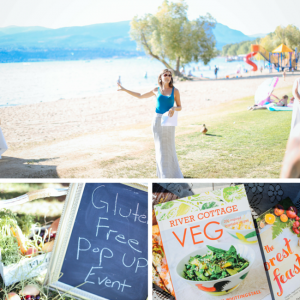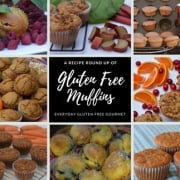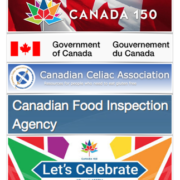Selena De Vries, RD Shares 10 Gluten-Free Foods That Always Fill Her Grocery Basket
Ever wonder what is in a celiac dietitian’s grocery cart? Well, now is your chance! These foods are always stocked in our house, making meals easy to throw together with the pantry staples I keep in our cupboard, too (a post for another time).

Selena De Vries, RD
About Selena De Vries, RD
- Selena is a Registered Dietitian living with celiac disease who helps individuals that struggle with digestion find food freedom. At Healthbean Nutrition, Selena understands that celiac disease not only effects our physical health but also effects our emotional health. As such, Selena uses an integrative approach in the management of digestive health conditions. She offers free group support for those with celiac disease/gluten sensitivity as well as offering nutrition coaching for digestive health conditions. Services are offered both online and in the beautiful Okanagan valley.
Click here for Selena’s Top 21 Simple & Energizing Gluten-Free Snack Ideas!
 Not only do the foods below make healthy, gluten free meals in a jiffy, but, many also contain key nutrients that celiacs need more of and/or tend to be deficient in.
Not only do the foods below make healthy, gluten free meals in a jiffy, but, many also contain key nutrients that celiacs need more of and/or tend to be deficient in.
1. Plain Kefir:
I like kefir (or plain yogurt) for the probiotic content. Research shows that celiacs tend to have low amounts of good bacteria in the gut, including bifidobacterium and lactobacillius. Liberte Effervescent Kefir contains 33 billion live active bacteria per 100mL and include strains of the above bacteria. As a comparison, some of the highest quality probiotic supplements out there, contain 50 billion per serving (1 capsule/serving, typically). So, this is a great way that is much more affordable to get in your daily probiotics. I always like to recommend food first before a supplement!
Just watch the flavoured varieties, they tend to be sky high with added sugars.
- Dose: start with a small amount at first (1-2 TBP/day) and work your way up to 100mL.
- Brand Name Suggestion: Liberte effervescent organic plain 2 percent kefir.
- Use: You can just drink it, or a more popular/satisfying way to consume is using it as part of the liquid called for in smoothies or mixing a little bit into greek yogurt/thick yogurt which will yield a thinner yogurt.
2. Dark Leafy Greens:
Leafy greens are easy to add to multiple different meals in the day to up your veggie intake. In addition, leafy greens are a good source of folate, which is a nutrient of concern for celiacs. A lack of folate or folate deficiency would result in a folate deficiency anemia with symptoms that would be similar to iron deficiency anemia.
I like to rotate through different dark leafy greens such as romaine lettuce, kale, arugula, swiss chard. We do tend to have our favorites which seem to be bought more often in our house, including spinach which is great for smoothies as they really do not change the flavor and kale which is great in salads if you massage the de-stemmed leaves first with a pinch or two of salt to remove the bitter flavor.
- Use: Add a handful of greens into smoothies, soups, stews, stirfries, casseroles or stuff into sandwiches/wraps/quesadillas/tacos. The options are endless!
- Store: Don’t let leafy greens go bad! Store them in the freezer when they start to wilt and then you can still use them in smoothies, soups, stews, stirfries, and casseroles.
3. Ginger:
We go through a huge ginger root on a weekly basis at our house. Ginger is very good at calming gas pains and improving intestinal transit time (helps to move food through the intestinal track so it can be helpful for constipation prone individuals). It is also very well known to help with nausea. So, ginger can be a celiac’s best friend, especially if you accidentally get “glutened.”
- Use:
- Use 1/2″ ginger root chunk in your smoothie (we use the skin and all)
- Cut a 1″ chunk into small pieces and steep for 15-20 minutes in water and drink as a tea. Add lemon and honey, if desired.
- Grate frozen (skin and all) into stirfry or asian inspired dishes.
- Store: We usually cut the majority of the root into 1/2″ chunks for smoothies and reserve a few larger pieces for grating into dishes. We store both the smaller chunks and large pieces in a ziplock in the freezer, skin and all.
4. Lentils:
The almighty lentil. So, delicious and so hard to find as truly gluten free. Lentils are a high risk ingredient and should be purchased with a ‘gluten free’ claim or certification logo.
They are extremely high in fiber, like all beans and legumes, and a match made in heaven for a celiac. This is because fiber content typically drops on the initiation of a gluten free diet, leading to even more gastrointestinal discomfort, which is what we want to avoid!
Lentils are also a great source of plant based iron (non-heme iron). Although, the body has a harder time absorbing this type of iron, combining lentils with a vitamin C source (like bell peppers or tomatoes) and sprouting the lentils, if you have time, can improve the absorption of the iron found in them.
- Brand Name Recommendations: Tru Roots Sprouted Lentils and Clic Lentils
- BC Outlets that Carry Clic Lentils: Dan-D Foods (11760 Machrina Way, Richmond), S.Shivji Ventures (9-1080 Cliveden, Delta), Valoroso Foods (1467 Sutherland Ave, Kelowna), Bosa Foods (1465 Kootenay Street, Vancouver), Jasmine Mediterranean (8589 Fraser Street, Vancouver).
- BC Outlets that Carry Tru Roots Lentils: Save on Foods, Costco, Choices Market, Safeway
5. Salmon:
I love salmon. I don’t know about anyone else, but I crave it and couldn’t live without it!!
Omega 3 is another nutrient of concern on the gluten free diet (we could get quite into detail here about the omega 3:6 ratio, but I will leave that for a potential future post). Most individuals, celiac or not, can benefit from eating more omega 3. Aiming to eat animal based and plant based sources of omega 3 is a great to boost your intake of this much needed nutrient.
For fish eaters, I typically recommend to eat fish once/week and include plant based sources of omega 3 everyday (see 8 and 10 below).
6. Grass Fed Beef:
Grass fed beef is higher in omega 3 than conventional grain fed beef. In fact, conventional beef has about 20 milligrams of ALA (alpha linolenic acid – an omega 3 fat) in three ounces, whereas the same amount of grass-fed beef has 50 to 100 mg.
In addition, beef is a great source of animal based (heme) iron which is easily absorbed in our body. Lack of iron in the diet or a deficiency of iron, would result in symptoms of iron deficiency anemia.
7. Bananas:
Probably the most versatile fruit. It’s moistness and soluble fiber content lends well to gluten free baking, and it’s sweetness is great for smoothies and healthy, sweet treats.
- Recipes:
- Gluten Free Banana bread (I add chocolate chips to this as I have chocolate chip obsessed husband).
- Detox green smoothie
- Frozen chocolate banana bites: Cut banana into 1″ chunks and place on top of parchment paper, drizzle with melted chocolate. If you feel fancy, sprinkle chopped nuts on top of melted chocolate. Place in freezer to freeze and munch on when you get the desire for something sweet.
8. Flax:
This is a seed and, again, is a high risk ingredient so it is important to purchase this ingredient correctly by reading labels.
Flax is a seed that is high in fiber and a good source of omega 3 and plant based protein. So, a great functional food for celiacs. Ensure to grind whole flax as whole flax seed on it’s own is too slippery and will bypass digestion if left in that form.
- Dose: 1-2 TBP per day
- Use: easy to add into smoothies, or sprinkle into grain/grain dishes, sprinkle on top of jam/nut butter on toast, or add into salads.
9. Frozen Berries
Out of all the fruits, berries rank among the top for fiber content, which celiacs typically do not get enough of. That, paired with the fact that they make easy snacks and great additions to smoothie, makes them a staple in our freezer.
- Use:
- Put frozen berries into greek yogurt the night before you plan to eat them, and then you have a ready to go snack for the next day or top with granola for a simple, high fiber breakfast.
- Make double when making smoothies. Make extra smoothie in the morning and save extra for a snack later on in the day or even the next day.
- Add into muffins
- Top with ground flax or hemp hearts, unsweetened coconut, and a dollop or almond butter for a yummy, dairy free, berry bowl.
10. Hemp hearts:
This is a seed and, again, is a high risk ingredient so it is important to purchase this ingredient correctly by reading labels.
Hemp hearts are high in fiber, a good source of omega 3 and plant based protein just like flax. No need to grind these, however. You can use these the same way you would as flax seeds.
Hemp hearts are definitely more tricky to find gluten free. I buy the majority of my nuts and seeds from Prana, where they are all certified gluten free.
- Dose: 1-2 TBP per day
- Use: easy to add into smoothies, or sprinkle into grain/grain dishes, sprinkle on top of jam/nut butter on toast, or add into salads.
Living in the Okanagan or anywhere in British Columbia? View Selena’s services or book an appointment!
- Contact Selena for in-person or on-line support
- HealthBean.ca • Facebook • Twitter • Instagram • Pinterest • Videos • Blog
- [email protected] • 1-778-990-6047
Testimonial
- “I contacted Selena when I still wasn’t feeling well a year after my celiac diagnosis. I’d read so much on the Internet I thought I knew everything I needed to know. I was wrong.
- Selena has important advice on how to do GF properly (it’s not as straightforward as I thought) and for regaining your health. She is organized, punctual, and professional. And she has celiac disease herself , so she gets it.
- I think a lot of us, by the time we’re diagnosed, have had more than our share of health care practitioners and may not want to bother with a dietitian.
- Selena played a crucial role in my recovery, and I would highly recommend her, whether you’re newly diagnosed or just trying to feel better.”
- ~ Charlene (long-distance celiac disease client)
- HEALTHBEAN NUTRITION specializes in digestive health. We deliver easy to digest, bite-size pieces of information so our clients can, finally, achieve the healthy & happy digestive system they’ve been striving for. Learn more ...
- HEALTHBEAN PHILOSOPHY– Selena employs elimination diets and/or a specific diets in accordance with her clients’ conditions, and only when deemed necessary. She reserves advice about the gluten-free diet for those who require it – not those choosing to follow the diet as a lifestyle choice. Expect clear, concise instructions on the appropriate diet for you and, maybe even some myth busting! Learn more …
Selena knows first-hand how her undiagnosed celiac disease affected her physical and emotional health. After telling her that, “Well, you have celiac disease,” her MD suggested she, “google the diet,” and out the door she went. Sound familiar?
That’s why Selena established Healthbean Nutrition. She is dedicating her education, personal insights and her own recovery to helping her fellow celiacs make this enormous lifestyle transition – and find joy in eating again! Learn more …
Selena’s Road to Diagnosis
- “When I was going through university, I was exhausted, ALL the time. I had to drag myself out to hang out with friends, and if I had it my way I would have spent most days in bed sleeping. It was not unknown for me to sleep 12-16 hours a day. Call me crazy, but I related it all to the busy-ness of school. I was even checked for anemia at one point (common with celiacs) and I was ‘fine.’
- The symptoms continued through school and the brain fog was undeniable. I distinctly remember during my dietetic internship (like a medical residency except everything is nutrition based) at Kelowna General Hospital sitting in the office, charting on a patient and, literally, feeling like my brain was so fuzzy that I could barely keep my eyes from nodding off. It was awful.
- Another thing I didn’t pay much attention to, was bowels. I was always constipated. Never the other way around. Never. And, I also remember mentioning this to my gastroenterologist just before the endoscopy and he said ‘oh, well with your very low antibody levels and constipation, there is a very low chance that you are actually celiac but we will proceed with the endoscopy since you’re prepped and ready to go.’
- The piece of paper I received after the endoscopy said to follow up with my GP. I did follow up with my GP and the report came back positive for celiac disease. My GP said “well, you’re celiac. But, you’re a dietitian, right, so this should be easy for you!”
- Perhaps I had a leg up in the nutrition part of it, but I think we all know that the gluten free diet is not a walk in the park. And, although, I am so appreciative of the medical care I received, it did open my eyes to the lack of knowledge within the medical community when it came to celiac disease and the lack of support offered to individuals with celiac disease.
That’s how Healthbean Nutrition was born!
Leave a comment at the bottom of the page.
- *Information and perspectives posted on The Celiac Scene are intended to provide general information, without independent verification on the part of The Celiac Scene for the accuracy of the information provided to it. The information is specifically not intended to be a substitute for medical diagnosis or treatment by your physician or other health care professional. Always consult your own physician or other health care professionals about any medical questions, diagnosis, or treatment, especially before trying any diet. Healthbean Nutrition does not accept any liability for any injury, loss or damage incurred by use of or reliance on any content contained herein.
















